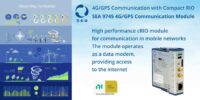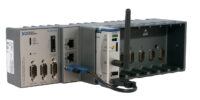CompactRIO
S.E.A.-Module für die NI CompactRIO-Plattform
Erweitern Sie Ihre NI CompactRIO-Plattform um drahtlose Kommunikation, GNSS-Positionierung/Zeitbestimmung, digitale Präzisionspositionierung und vieles mehr.
Was ist CompactRIO?
Das CompactRIO ist ein modulares, kompaktes, robustes und offenes Messsystem der Firma NI, bestehend aus einem Echtzeitrechner sowie einem Chassis zur Aufnahme von Funktionsmodulen, den sog. cRIO-Modulen. Das Chassis kann je nach Modell 4 oder 8 cRIO-Module aufnehmen und verfügt über ein FPGA (Field-Programmable-Gate-Array). Weiterführende Informationen zu CompactRIO finden Sie auf der NI Website.
Neben CompactRIO existiert noch die NI CompactDAQ-Plattform. Diese Plattform ist eingeschränkt und nur mit bestimmten S.E.A.-Modulen nutzbar.
Was bietet S.E.A. für CompactRIO?
Wir bieten sogenannte Third-Party-cRIO-Module an. Diese stellen diverse Technologien bereit und helfen damit die Plattform um eine Vielzahl von Fähigkeiten zu erweitern.
Neben den bereits existierenden Modulen können wir Module auf Kundenwunsch entwickeln.
cRIO-Module mit Technologien wie Mobilfunk (4G), Geopositionierung (GNSS), Schnittstellen und Busse oder Networking.
Module ansehen
Zubehör: Mobilfunk/GNSS-Antennen, Montagevorrichtungen, Kabel
Zubehör ansehen
Grafische Displays
Displays ansehen
Modulentwicklung auf Kundenwunsch
Kontaktformular
Kundenspezifische Anwendungserstellung rund um die NI CompactRIO-Plattform
Kontaktformular
S.E.A. cRIO-Module
Mobilfunk (4G) und Geopositionierung (GNSS)
Funktionsvergleich Mobilfunk/GNSS-Module
Möchten Sie das passende Modul für den Bereich Mobilfunk / Geopositionierung finden? Diese Tabelle hilft Ihnen dabei.
| Funktion | SEA 9406 | SEA 9744 |
|---|---|---|
Mobilfunkstandards | nein | 2G, 3G, 4G |
GNSS-Standards | GPS, GLONASS, Galileo, BeiDou | GPS |
GNSS-Positionsgenauigkeit | <0,2 m (mit RTK) und 1,5 m CEP (ohne RTK) | 2,5 m CEP |
Unterstützung für GNSS-Korrekturen | Standard-RTCM-Korrekturen via Netzwerk-RTK (NTRIP) | nein |
GNSS-Aktualisierungsrate | 20 Hz | 4 Hz |
Schnelle GNSS-Fix-Zeiten | ja | ja |
Konfigurierbares Timepulse-Signal | ja | ja |
Erweiterter Temperaturbereich | Option | nein |
Integrierter IMU-Sensor | Option | nein |
Weitere Hinweise | neu seit 2022 | Einsatz weltweit, außer USA u. Japan |
Kundenanwendung
Hurrican Beobachtung Harvey’s Eyewall at Landfall

Das sagen
unsere Kunden
Typische Einsatzbereiche
Einige Beispiele für den Einsatz unserer cRIO-Module

Interessiert?
Lernen Sie unser cRIO-Produktportfolio kennen.
- Besuchen Sie unser Webshop
- Für kostenlose Treibersoftware
Nach der Installation stehen Ihnen zahlreiche LabVIEW-Beispiele zur Verfügung. Die Evaluierung der Treiber funktioniert auch ohne Hardware, lediglich eine NI LabVIEW-Entwicklungsumgebung inkl. entspr. Softwaremodule (Real-Time und FPGA) wird benötigt.



